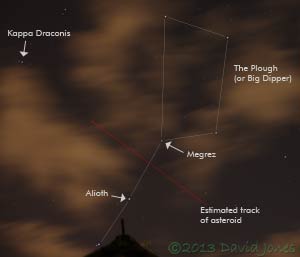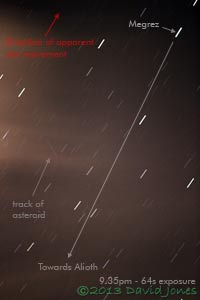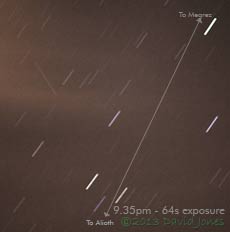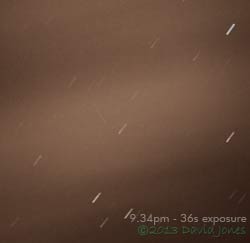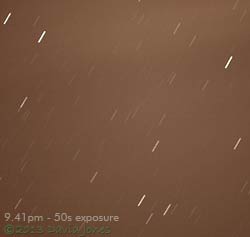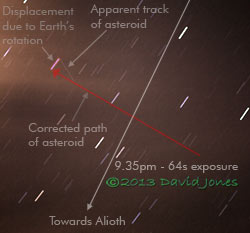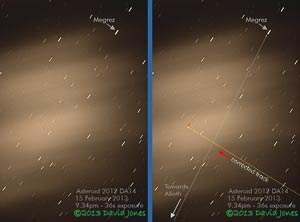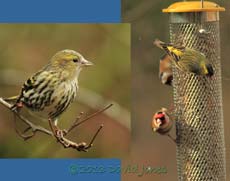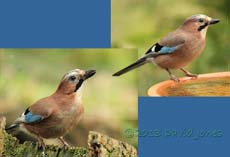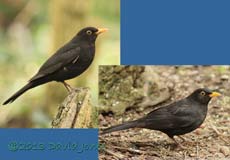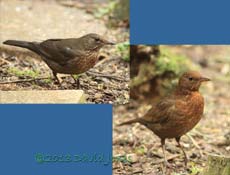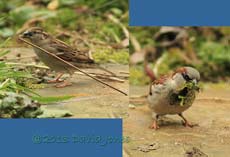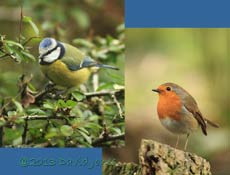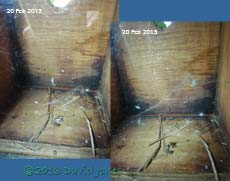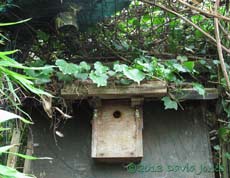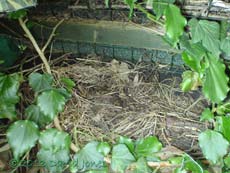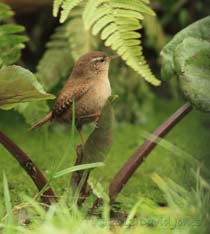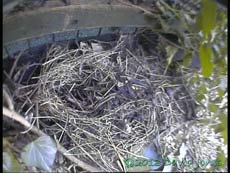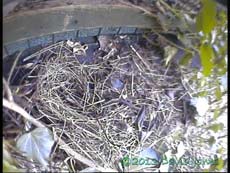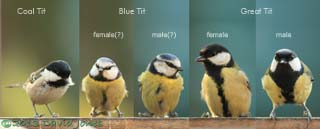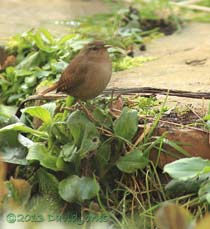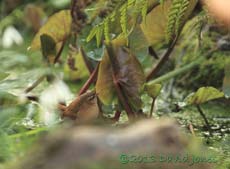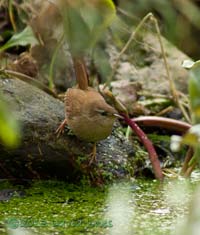Go to the last entry on this page .....Go to previous entry
16 February - Since that last entry the temperatures here have risen and we have seen a couple of daytime highs of around 10C. It has been mainly dry (except when I took Evan on a 'duck watch' in the Brickfields Park two days ago and we were caught out by a sudden heavy shower). It has been a rather hectic week as we have had Evan with us for most of the time. This has meant little time for the diary, although he is always keen to look out for the birds in the garden. The day before yesterday we saw three Siskins (including two females) at the sunflower feeder, and a Jay appeared here yesterday. This morning I spotted a Dunnock under the Hawthorn - at present this is only a very occasional visitor as opposed to the regular that were are used to. In the big pond I'm seeing the odd disturbance on the water surface, indicating that frog activity has begun, by so far there have been no photo opportunities.
Asteroid 2012 DA14 With yesterday (15 February) providing what amounted to perhaps a once in a lifetime opportunity to observe an asteroid passing the Earth, missing by a mere 27,700km (17,200 miles) I was delighted when I saw that its predicted path would bring it into a good viewing position (and at a good time for me) to the north of mybitoftheplanet as it crossed through the constellation of Ursa Major (The Plough). Called Asteroid 2012 DA14, it was discovered in February last year and the flyby will be a record close approach for an object this big. My fingers were firmly crossed for clear skies. In my planning I used the excellent star charts provided at www.heavens-above.com. The night before last the skies were indeed clear around the optimum time for pinpointing the asteroid's position as it crossed the 'handle' of the Plough at around 9.30pm. From my back garden the Plough is seen to rise in the North-East, over the roof of my neighbour's house, and the important area of interest would be well clear of that obstruction. I decided that I would use two cameras, one with a 50mm lens and set to record a sequence of images at regular intervals to use as a back-up for the main camera with my 300mm Nikon lens used to pinpoint the region more precisely. I would also set up my larger spotting scope. Well, All looked perfect for last night when during the day the Met office forecasted clear skies again for the event itself. Unfortunately, my optimism was badly battered as it became clear that after dusk the skies were not going to starry! However, as the cloud blanket was just a bit moth-eaten in places I decided to at least set up the two cameras - it wasn't worth bothering with the scope. The camera with the 50mm lens was easily arranged as I knew the area to point at, and soon the camera was clicking away every couple of minutes taking pictures of orange tinted clouds with just the occasional star in sight.
I've labeled two of the stars of the Plough as I knew that the asteroid would cross the imaginary line between these at about 9.33pm. I have also labeled the star Kappa Draconis which I hoped to to use as second target area at around 10.40pm.
Kappa Draconis is a Blue Giant star that is part of the Draco constellation and you may just see its blue colour in the large image. It is actually 1400x the brightness of our Sun but is 489 light years away. The track of the asteroid would take it just below the position of that star which would provide a convenient target when moving the 300mm lens. Anyway, while the first camera clicked away, I waited patiently for the time when the passage of the asteroid would bring it to the Plough, hoping for the rather slim chance that its arrival would coincide with a break in the cloud cover. For a while before 9.30pm I pointed the long lens at just about any small patch of clear sky that appeared towards the east, but none of those shots captured anything but parallel star tracks. However, as 9.30pm approached the chance of a gap in the clouds revealing the lower portion of the Plough improved somewhat. The problem that I had then was pinpointing the star Megrez (see above) as I needed to place this at the top of the picture. With Megrez being by far the dimmest of the Plough's stars, it was easier to look for Alioth, the brightest star in the whole of Ursa Major and then move the camera up slowly, hoping to find Megrez exposed at the same time.
The sky never cleared completely around this key area, but having Alioth show through thinner cloud allowed me to get the camera lined up just after the ideal time of 9.30pm, and a 64 second exposure captured this image. It shows a large number of star tracks, identical in length, created by the apparent movement of the stars towards the top-right corner of the image as they appear to rotate around the pole star. However, a close look reveals one track at between 60-70 degrees to those of the stars.
This line matched reasonably closely the predicted path of the asteroid and brought a smile to me when I found it once back indoors. I needed confirmation before getting too excited and I found what was possibly that in the previous frame, taken a minute and 23 seconds earlier -
The star tracks are shorter this time because of the shorter exposure, ended early (after 36 seconds) when thick cloud obscured the area. However, despite the red light pollution 'fog', look carefully at the large image and you will see the possible asteroid track again, in a different position, again where I expected it to be, although it is again not quite in the correct direction.
Finally, a third image of a similar area, extended to the left and top, and taken at shortly before 9.41:45pm. While this 50 second exposure shows all the star tracks already seen in the other images, there is no further sign of the track that crosses their paths - the asteroid had moved on out of frame.
I should point out before going any further that of course the star tracks are not actually parallel. As the Earth rotates they appear to describe circular paths around the pole star (beyond the top-left corner of the images), with that circle being larger the further the star appears from the pole star. However, in the small area of the sky covered by my lens I hope it is forgivable to regard adjacent star tracks to be more or less parallel. It's interesting to note that the >60 degree angle between star and asteroid tracks at first appears to be at odds with its predicted path which suggested that it would cross the 'tail' of the Plough at close to a right angle. Also, when you take a first look at the images taken at 9.34pm and 9.35pm the two asteroid(?) tracks do not follow in what you might expect to be a straight line.
However, while the rotation of the Earth caused the stars to produce those streaks of light in the images, it also caused a similar apparent motion in the asteroid. The left hand end of the path recorded in the two images has been displaced in the same direction and by the same amount as the stars. Remove this distortion and the track is indeed just about at right angles to the line between Megrez and Alioth, and now follows more or less exactly the predicted path followed by Asteroid 2012 DA14.
Although I have not shown it here, the adjustment, if carried out on the 9.34pm image will result in both it and the 9.35pm track lining up in the expected straight line after all.
I took that opportunity to add a 'course correction' to both images, confirming how the object was definitely following the predicted course of the asteroid. While the times on the images show 9.34pm and 9.35pm, according to the camera they were 9.34:21pm and 9.35.44pm, so the exposures started 1m 23s apart.
Well, I may not have had the chance to actually see Asteroid 2012 DA14 but I'm now satisfied that I have indeed recorded just a bit of its flyby in sight of mybitoftheplanet! I see from Wikipedia that this 'near miss' has altered the orbital period of Asteroid 2012 DA14 from 368 days to 317 days and its next notable close approach to us will not be until 2046 when it will not pass closer than 1.5 million kilometres from the centre of the Earth! So I guess that there will be no further such photo-opportunities for this generation unless another suitable candidate makes an appearance ..... And finally, what happened to Kappa Draconis? The answer is simple - cloud. Within minutes of my taking the above images it became obvious that the cloud moving in from the north-west was getting thicker and wasn't likely to provide me with any more photographic opportunities until after the asteroid had passed that target. So I packed up, rather disappointed, and not knowing at the time that I had in fact succeeded! All the images have received some overall processing to reduce the effect of light pollution, but otherwise none have been retouched, apart from the addition of labeling. Isn't there a good comet on its way to loop around the Sun later in the year?!
23 February - Since that last entry the weather has been pretty boring in as much as it has remained dry and mainly cloudy, with the temperature remaining within a few degrees of freezing, sometimes feeling even colder thanks to a chill wind. For much of today there have been occasional snowflakes falling, only for most to disappear rapidly on landing We have been quite busy with family matters, including quite a bit of time with our grandson during the week. One day he and I spent a few hours in the Brickfields Park, enjoying the ducks and Canada Geese (which polished off five loaves of bread provided by two women while we watched!). I had taken some chopped up cabbage leaves in accordance with RSPB advice but these were rejected out of hand - we shall take some stale cake and/or grated cheese next time we go. Today I had the first opportunity to spend time watching the garden for over a week, and things got off to a good start even before I came downstairs. One of the first birds I noticed when I looked out of our bedroom window was a Wren that was hunting along the edge of the small pond. Unfortunately, by the time I got downstairs it had gone, not to return again during the day.
The Siskins continue to feed here - I see no more that one male and/or two females at any one time, with the feeders visited frequently during the day, and usually, but not always, when there are also Goldfinches present.
The Jay on the left in these pictures arrived first, perching on a log under the Hawthorn. As I watched it suddenly crouched low and seemed to adopt a submissive (or defensive?) posture as the second bird landed on the rim of the birdbath, less than a metre away. The first Jay then headed back down to the far end of the garden.
The other bird has some white feathers associated with the leading edge of its right wing.
The two other Blackbirds are very different in appearance. One (on the left) has what I expect as the normal colouring/markings of a female. The other was lighter and had quite a reddish colouring. I shall have to watch out for it again.
Every-so-often a group of males and females will descend onto the area around the big pond where there is a lot of dried vegetation where they will tug on individual blades of straw or moss. If they succeeded in freeing a piece it would be carried off in the direction of the nest boxes. Occasionally I would also see one pecking off and eating chunks of green leaves.
The Dunnocks are still reluctant visitors, and I saw just one visit once during the morning, and there were no Starlings here today. On the other hand, the Robin is back and forth all the time - just the one bird as far as I could tell today.
The heavyweights, the Wood Pigeons, are being a bit of a nuisance at the moment, moving in quickly to snap up any chopped peanuts and just about anything-else that I put out on the ground for the Blackbirds, Dunnocks etc. I deliberately refrain from scattering more than a little at a time, with long gaps between, but the pigeons continue scour the ground for whatever they can find, squabbling with each other over the scavenging rights. At least the Jay(s) will check out the bird table when there is nothing to be found on the ground. No photographs to record them, but the crocuses have started flowering over the last week. During the last week I took photographs of the interior of the Blue Tit box over an interval of three days to confirm whether or not the box was being visited. There are some bits of straw and a couple of bird droppings on the floor of the box and I wanted to see if these were moved about at al. As it turned out, nothing moved between photographs, suggesting no activity during that period, although the presence of droppings does indicate that the box has been visited at some time since the last nesting season. I must get the cctv cameras switched on in the box. I must also check the camera that monitors the roof of the box just in case the Blackbirds try nesting there again this Spring - a job to do this coming week I think/hope.
24 February - Another cloudy, cold day with the temperature hovering just above freezing and just the occasional snowflake falling. All seems extremely quiet on the bird front today - even the Wood Pigeons are staying away.
Just after 1.30pm I went down the Blue Tit nest box to check it once more. There is still no sign of any activity, as suggested by these photographs, taken four days apart. I need to get on with cleaning the glass, just in case things change over the next month or so.
Could it be that we will have more luck on the roof of the box? In this picture of the nest you can see the extended roof and the anti-cat mesh that protects it. The round object suspended from that mesh contains a cctv camera that is directed at a spot used twice in the recent past by a Blackbird. Sadly, for different reasons her efforts failed. The site is protected from direct sunshine by a green mesh cover (visible above the camera).
I've just trimmed away some new Ivy shoots ready for when the Blackbirds embark on their nesting season - tomorrow I may take away a bit more on the left side. Last year the female started building her first nest before the end of February, when conditions were definitely milder than they are at the moment.
25 February - The dull, grey skies continue to blot out the sun, although today is a couple of degrees less cold, at just over 4C at 10.30am. And it is still dry. Taking a look at the water level in the big pond this morning suggests that I need to empty a water butt into it.
Yesterday I mentioned spotting a Wren. This morning it was back again around 10am, and visiting the same spot, a stone in the small pond from where it fishes for invertebrates amongst the duckweed. I had just this one opportunity to take a photograph as it moved around the margins of the pond for several minutes.
The Wren was back again at around 1pm and again I had just one chance to photograph it as it darted around the pond. Here it's perched on a new Marsh Marigold leaf. The dull conditions are frustrating - the shutter speed for this shot was just 1/50s - far too slow to get a sharp picture through the equivalent of a 4200mm lens!
Last night I confirmed that the nest box cameras are all working at the bottom of the garden, and this afternoon I've checked video and audio connections back to the house and set up a hard drive recorder so that I can start monitoring the Blackbird site. This shows the initial image of the nest site, with the remains of the 2012 nest and which I can now use as a comparison to detect any activity from now on.
If nothing else shows up over the next few months I would almost expect the Wren to pay the site a visit, if only to pinch nesting materials - something it did last year!
26 February - Another desperately dull day, and damp as well, so poor was the light at around 9am that when a male Greenfinch turned up at the feeder I didn't even consider pointing the camera at it! The Wren has also reappeared this morning, visiting the small pond at least twice. Perhaps the one positive for the day is that the temperature reached 5C this afternoon. Last night I found a problem with the radio microphone that I want to use to help monitor the Blackbird nest site. After last year's nesting season was over I made the mistake of leaving the unit in position, and while the transmitter unit was well sheltered the microphone itself was more exposed to dampness (although not direct rain). As a result, corrosion had created some poor connections. I spent an hour or so dismantling and cleaning it. It's now back in operation and is now working well enough to pick up the Robin singing near to the site.
This view is now being recorded throughout daylight hours, although not on my timelapse recorder which is being used for other duties.
27 February - A day of two halves, at least weather-wise. A damp, drizzly start before breakfast improved as the morning progressed, and during the afternoon the skies turned from grey to a hazy blue as the air pressure dropped slightly. With the sunshine came a slight rise in temperature from just 1C at 9am to 5C for a couple of hours in the latter part of the afternoon. It may have been down to the sunshine, but a couple Dunnocks were certainly in a Spring-like mood as they dashed around the Hawthorn for a few minutes around 1pm. Sadly I didn't see them again afterwards. And there was no return by the Greenfinch today, when I had the camera set up all ready for it! For a while this afternoon I pointed the camera at the back edge of the bird table in order to capture this next image (or rather, a set of images to create this composite picture).
Perhaps the comparison becomes more clear when you read that a Coal Tit weighs about 9g, a Blue Tit 9 - 12.5g and a Great Tit 16 - 25g. I'm pretty certain about the sexes of the Great Tits, the male having the very bold black bar down its front. The Blue Tits are more difficult. For the moment I've labeled the right hand bird as a male on the strength of what I think are its bolder colours, especially its blue crown. The smallest of the three species, the Coal Tit male cannot be distinguished from the female in photographs (even if you have pictures of the pair!).
Late in the afternoon I spotted a Wren hunting around the small pond once more. Again, I had just a single, and all too brief opportunity to photograph it in the open. Just after I took this picture it moved nearer the water, and as it did so a second Wren flew in from behind the Hawthorn, with one flying off as soon as this happened - the first time I can recall seeing a pair here.
For the next twenty minutes or so I was able to see one hunting the vegetation and water surface of both ponds, managing to remain at least partly hidden at all times, except when one was in clear view at the far end of the big pond - no chance of a picture at that range.
28 February - The month ends with another dry day, and although persistent high clouds meant that the skies didn't quite turn blue the temperature got up to 7C during the late afternoon - there was no need to wrap up warm while I investigated why my wooden shed was beginning to smell a bit damp! The problem was down to me, I'm afraid. The north side of the shed, hidden from view from both me and our neighbour by a high fence, had some long bits of metal resting along side it a couple of feet of the ground. Unfortunately, leaves falling from my neighbour's Birch tree over the last couple of Autumns had piled up in the metal and acted as a sponge for rain water, a situation not helped because the guttering had been blocked for the same reason. The leaves and metal have now been cleared away and with the forecast suggesting dry conditions until at least next Monday the shed wall should have a chance to dry out enough for me to check if any timbers need replacing - a first glance suggests that I may be able to get away with just re-treating the wood (fingers crossed!). Anyway, despite the brighter. warmer conditions there have been no signs in our garden that either female Blackbird is quite ready to commence nest building before the start of March. In 2012 it was on the 28th (which had a high temperature of 12C after an overnight low of 8C) that I saw the first soggy materials being collected from the big pond. The two females I recorded a few days ago have both turned up to feed and bathe (as have both males) today but that's it so far, and the monitored site remains undisturbed. The reddish tinted individual doesn't look quite so red today, although it does look much more uniform in colour than the other female and definitely has a slightly 'warmer' colouring. I must take another photograph of it to compare with my original shot.
The Wrens seem to have put the ponds into the daily schedule now. They(?) were here in the late afternoon again, hunting around both ponds.
This time I decided not to follow them but instead point the camera at one spot and wait. In 45 minutes I had just this brief moment when one paused for long enough for me to react, using a cable release to get two shots before it darted off again. Click on images to see larger versions
|
|
